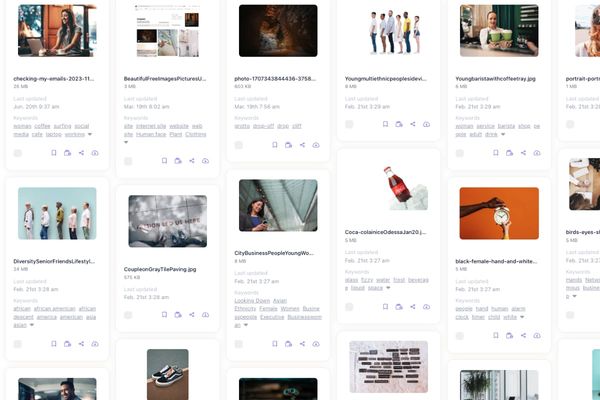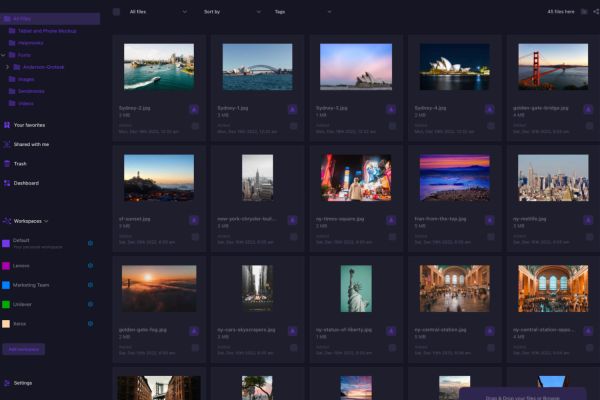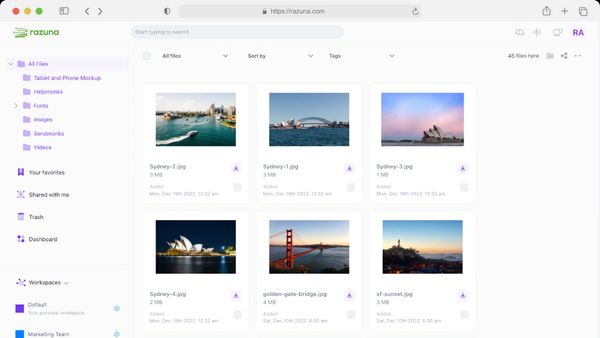
What Is Digital Asset Storage?
What is digital asset storage? This guide to digital asset storage has all the answers. Learn how to implement digital asset storage for all your teams.
Read nowYour digital assets are all elements of your organization's story, and effective digital asset management is crucial for preserving and safeguarding them. But amid all the technological changes sweeping the world, are your digital management processes still serving you as they should?
It may be time to reimagine how you manage your company's digital assets. We're here to help with an overview of the top 15 trends and innovations shaping the future of digital asset management (DAM) systems.
If you're ready to embrace the now, the new, and the next big thing, then keep reading. We've taken a closer look at the hottest new trends in digital asset management and why they're worth considering.
Digital asset management (DAM) is a software solution businesses can use to organize, store, share, and distribute digital assets. It allows teams to categorize these digital assets into Word documents, images, video clips, audio files, and more folders.
Good digital asset management software allows you to collaborate on, edit, and review such assets. Many DAM strategies employ automation tools, saving time, streamlining processes, and raising efficiency and productivity.
An effective DAM system is invaluable for brand development, marketing, and customer engagement. However, to stay in step with the latest trends in these areas, we must also embrace the trends and innovations in digital asset management.
So, it's time to examine the future of digital asset management systems.
What does the future of digital asset management look like? It's an exciting fusion of familiar processes with new technologies and approaches.
You'll notice immediately that many of these trends, while not complete innovations, are built on the foundation of existing tried-and-trusted DAM practices. Some are already here, some are in development, and others are waiting just beyond the horizon.
But one thing's for sure - the future of DAM is filled with possibilities, thanks to these 15 future trends and innovations.
Artificial intelligence (AI) and machine learning have become crucial parts of how we do business. So, it's hardly a surprise that this is already making its way into management software that we use, in the future of digital asset management.
We're all familiar with the laborious process of manually creating metadata and tags. These descriptors make it easier to categorize, search for, and retrieve digital assets, streamlining all your digital asset management processes.
But all that effort can be a thing of the past with the move to smart, automated tagging and metadata. Machine learning will automatically generate these metadata and tags, enhancing organization and speeding up digital asset search and retrieval.
Those machine-learning algorithms are good for much more than facilitating easier categorizing of files or faster search and retrieval. They're good for enhancing the quality of your digital assets, too, when relied on for content recognition and analysis.
Machine learning and algorithms find patterns and make recommendations based on those patterns. That is what they do best. Content analysis and recognition features recognize and identify patterns in your digital content, helping you better align your new content with your brand.
Do your team members always have their heads in the clouds? We sure hope so. Cloud-based DAM systems are here, and they're here to stay! They will continue to play a pivotal role in the future of digital asset management.
Such systems offer the most affordable, resilient, scalable, safe, and secure file storage solutions. Cloud-based storage is flexible, allowing you to adapt it to your growing needs.
Cloud computing also allows your teams to work better together, retrieving files, sharing them, and collaborating on digital assets from any location at any time. With the rise of remote work, this is essential for seamless teamwork.
And their future digital asset management teamwork will be even better when supported by the best collaboration features.
Collaboration has always featured prominently in digital asset management because it's heavily relied upon for brand marketing, product design, development, and more. In the future of DAM, collaboration features will remain essential to DAM software.
We can look forward to many enhanced collaboration features in the future of DAM. Most of these, as noted above, will be cloud-based. One of the growing trends in DAM collaboration is a move to more mobile solutions. This, too, will give rise to more freedom in where teams choose to work.
Whether they're fully remote or hybrid, it will be a lot easier for them if your DAM systems offer the same functionality on all mobile devices.
Security will continue to play a major role in the future of digital asset management. As DAM technology becomes more advanced, so will advanced security measures be necessary to facilitate data security and privacy.
The usual security measures–access control and permission settings–won't always be up to the challenge. More sophisticated encryption technologies and multi-factor authentication will be in high demand.
AI will also play a role in detecting and preventing unauthorized access, downloads, and sharing of your digital assets. Despite many reservations over the increasing use of AI, we can all agree that this is an area where it's most beneficial.

In the future of digital asset management, DAM is so much more than just the storage and categorization of your entire digital asset portfolio. It will be a complete content hub and the digital heart of your organization.
It's already a central hub for the digital files used in brand asset management, digital marketing, and customer engagement. It's also often used to analyze, edit, and review content.
The advanced security measures that the future of digital asset management brings will allow us to take it one step further. That is a complete content hub where all the magic happens. More organizations will start using their DAM system for everything, from content creation to distribution and publishing.
This is the secret to true organizational efficiency: a central hub that brings all your processes together. Of course, you'll still need to use other platforms and software, especially for communicating with your audience. Fortunately, this will be easier with all of the new integration capabilities on the horizon.
Integrations are a big deal in digital asset management. When the different systems and software that your team relies on to work together seamlessly integrate, everything flows smoothly. Instead of an either/or situation, your teams can get the best out of multiple platforms and software simultaneously.
Thanks to new integration capabilities and improved interoperability standards, multi-platform management and collaboration will be the norm in the future of digital asset management. Sharing digital assets will be faster and easier without any loss of quality.
You can be sure that the future of digital asset management will be built on data analytics. More than just a trendy buzzword, data analytics has become more and more relevant to the business world in recent years. And predictive analytics will play a big part in the future of DAM for years to come.
By identifying the most commonly used digital assets and predicting when and how they need to be used, this feature will ensure that projects are completed in record time. It can also be used to build the framework for new digital asset collaboration projects in branding and marketing.
Much of the time wasted at the beginning of DAM processes can be attributed to searching for specific files. Resolve this issue, and everything that follows will happen sooner. That's why it continues to be a factor in the future of DAM.
Expect advanced AI-powered search and automated tagging and keywording in the future of DAM systems. With these features, you'll save even more time, which will knock on productivity. Easier searches make DAM software easier to use, even for the beginners on your team.
Regarding user-friendliness, user interface (UI) improvements are also on the cards. In most organizations, the digital asset management system is used by multiple staff members. Team leaders and managers will access the system to review and approve ongoing work. Your company may even be collaborating with outside parties on specific projects.
But with so many users and different levels of tech skills, you need a user interface that makes all this activity simple for everyone. It should be customizable, uncluttered, efficient, and engaging.
A good user interface is the key to efficiency, individually and collectively. That's why the focus in the future will be on streamlining the interface as much as possible while retaining appeal even for more tech-savvy users.
Looking at some of the biggest trends to hit the business world in the last few years, we notice that many are aimed at sustainability. Recycling, reducing waste, reusing and repurposing products - that's what had everyone talking.
This continues to be very important and will also make its mark in the digital world in the future. Indeed, one of the most exciting future DAM trends is AI-driven asset repurposing. This entails leveraging AI algorithms to transform digital content into other formats for different platforms.
Why is this so important? You will engage with a wider audience, maximizing the value of your digital assets. It saves precious time and resources, making this the ultimate move towards digital sustainability.
Once you tap into that wider audience, you'll discover the secret to maintaining user engagement. Adaptive rendering is one of the trends for the future of digital asset management that will help you achieve it.
Adaptive rendering creates adaptations of your digital assets at scale for use in different formats and platforms. It adapts to different bandwidths and screen sizes, optimizing content for each user's unique needs.
Mobile phone, tablet, desktop - it doesn't matter where or how they access your content. It will be rendered in the format best suited to their device of choice. This means that everyone that your digital content reaches will be actively engaged.

A content creation project, regardless of its scope and intention, relies on more than one image, one sound byte, or one word of text. There will always be multiple aspects to every piece of content. Even each of these elements can be broken down into smaller groups of digital elements.
With dynamic content assembly, your existing digital content library becomes the birthplace of even more creativity. The various elements can be manipulated to assemble content that is just right for each new project while staying true to your brand identity.
Automation relieved the workforce of repetitive and time-consuming tasks, and the workplace was never the same again. As we look into the future of digital asset management, we see even more time-saving features and tools and greater use of predefined templates.
Predefined templates are templates that are pre-formatted with your most often-used document layouts and features. You can then add to and enhance these pre-configured drafts for your web content, social media pages, product catalogs, and newsletters.
This will make life easier for several departments across your organization, producing quality content in a fraction of the time. Of course, predefined templates only save you time and effort at the preparatory stage. You will still need to add those personalized touches.
The future of digital asset management is all about how it can be personalized to enhance every user's experience. When you personalize the user experience, they feel a stronger bond with your brand. This helps to engage new customers and retain the interest of your more regular ones.
So, let's return to the wonder of algorithms because they will help you do this, too. Based on what's known about your target market and especially your regular audience, the algorithms will prompt a recommendation for personalized content.
It will be especially useful in strategies around exit intent triggers (the element triggered by a user's intent to leave the site or platform). Based on known data about the user/s, the content that is most likely to keep them engaged and on-page will be triggered.
A 360-degree video will pull your target audience into your world, where they can feel a stronger bond to your brand. You can look forward to greater 360-degree media support in future digital asset management systems.
360-degree media is the more accessible cousin of virtual reality (VR). While it does not offer the option to reach out and manipulate objects seen, as in VR, it nonetheless offers an immersive experience that is hard to beat.
This will give you two distinct advantages:
It makes producing new content for customer engagement easier, as your entire team will experience the content in new ways. Thanks to their new perspectives, this will help teams busy with video content collaboration to refine content further.
It enhances the entire experience for your audience. They're relying on what they see to form an opinion about your brand. They'll experience your content more personally and thus feel a stronger impulse to buy.
These 15 exciting trends above are just a taste of the future of DAM. As technology progresses, AI-powered and virtual features will become more commonplace.
The future of digital asset management looks bright, thanks to these trends and innovations. Yet, no matter how advanced technology becomes, you can always rely on Razuna to keep up with the latest trends. You can trust us with your digital asset management, brand marketing, and customer engagement software needs.
We offer a solid foundation of robust software with a clean, user-friendly interface and technologically advanced digital tools. This is the perfect platform on which to build your upcoming success. Register your free Razuna account today, and get the tools to skyrocket your business into the future!

What is digital asset storage? This guide to digital asset storage has all the answers. Learn how to implement digital asset storage for all your teams.
Read now
All files that your business uses is a type of digital asset. This guide explains the various types, what makes them crucial, and how best to manage them.
Read now
A digital asset management strategy is essential for your brand. This guide explores how to maximize your brand's potential with this powerful combination.
Read now
File organization is essential for any business. Here are 10 of the best file organization software options for businesses of all types to consider in 2024.
Read now
(each free accounts comes with 500 GB space)
